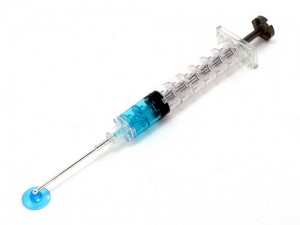
A robust, reproducible vaccine with low risk of side effects is hard to come by. A new design strategy could balance the benefits and risks of different vaccine approaches while making them as easy to build as Legos. (seanmichaelragan/Flickr)
Whole-cell vaccines rely on killed or weakened pathogens. Acellular or subunit vaccines contain only defined sets of antigens known to stimulate an effective immune response against the pathogen in question.
Both approaches have their strengths and weaknesses. Whole-cell vaccines carry a bacterium’s full complement of antigens and can activate many arms of the immune system at once. And they are inexpensive to manufacture. But these vaccines can be hard to reproduce and run the risk of causing frequent or serious side effects.
Acellular vaccines are very reproducible and run a much lower risk of side effects. But the immune responses they trigger aren’t as robust or durable, as evidenced by the recent failures of the acellular pertussis vaccines.
What if you could bring together the effectiveness of a whole-cell vaccine and the safety and reproducibility of an acellular one? That’s what Boston Children’s Hospital’s Fan Zhang, PhD, Yingjie Lu, PhD, and Richard Malley, MD, want to do with the Multiple Antigen Presenting System, or MAPS.
With MAPS, Malley is trying to bridge the gap between whole cell and acellular vaccines while developing a way to build vaccines almost like one would build with Legos.
The approach allows vaccine designers to select multiple protein and sugar antigens from a pathogen (or pathogens)—bacteria, viruses, parasites, maybe even cancer cells—and link them together in a modular fashion.
The resulting complex—which resembles a scaffold of sugars studded with proteins—can trigger both antibody and T-cell responses simultaneously, creating a more vigorous immune response like that of a whole-cell vaccine.
There are vaccines on the market today, called conjugate subunit vaccines, which combine multiple antigens. The difference is that their manufacture on covalent chemical bonding of their components, a difficult and inefficient process.
“The construction efficiency of most conjugate vaccines is roughly 20 to 30 percent,” says Malley, a physician and researcher in Boston Children’s Division of Infectious Diseases. “If you are trying to build a vaccine and only have a limited amount of antigen on hand, you just can’t do it; you’d waste too much material.”
As Malley and his team reported recently in the Proceedings of the National Academy of Sciences, the MAPS approach instead relies on two molecules—a B-vitamin called biotin, which gets attached to the sugar portion of a MAPS vaccine, and a protein called rhizavidin, which gets attached to the protein portion. The two molecules bind tightly to each other in an affinity interaction that, from a chemical standpoint, looks very much like the attachment of the two sides of a stretch of Velcro.
By holding the antigens together in this way, the construct helps the immune system “see” them in such as way that they look like one large invasive particle. The immune system then responds in kind.
It’s an arrangement that, in animals, works very well. Mice inoculated with MAPS vaccines containing tuberculosis (TB) proteins and pneumococcual sugars, mounted strong antibody and T-cell responses when challenged with TB. Mice that only received TB proteins could only mount antibody responses.
And 90 percent of mice given a MAPS vaccine of multiple proteins and sugars from pneumococcus were protected from lethal levels of pneumococcus infection, compared to 30 percent given the same components in an unbound state.
“By balancing the best of whole-cell and acellular vaccines,” he says, “we should be able to create combined vaccines to help address diseases that affect millions of children all over the world.”
In addition to its immunological power, the method also brings a new level of efficiency to vaccine construction. “With MAPS, we can achieve 90 to 95 percent efficiency,” Malley says.
He relates the story of a colleague who contacted him saying that he was having trouble manufacturing a conjugate vaccine for research purposes. Malley told him to send over the antigens. “In three weeks we sent him back a MAPS vaccine using his polysaccharides. With conventional approaches, it would have taken months with a much lower vaccine yield.”
That level of efficiency and speed could also help immunologists test new potential antigens and antigen combinations more quickly and advance vaccine engineering.
“It offers a new way of testing hypotheses and teasing out from a crude preparation of pathogen what the important antigens might be,” Malley says. “When you make a vaccine, you have of course to justify everything that is included. MAPS could provide an easy way to tell which potential antigens are protective, neutral or even harmful.”
Malley’s team is already using MAPS to develop vaccines for globally important pathogens like TB, pneumococcus and typhoid. They are also planning ones for group B streptococcus and whooping cough.
“By balancing the best of whole-cell and acellular vaccines,” he says, “we should be able to create combined vaccines to help address diseases that affect millions of children all over the world.”
![]() Citation:
Citation:
Zhang F, Lu YJ, & Malley R (2013). Multiple antigen-presenting system (MAPS) to induce comprehensive B- and T-cell immunity. Proceedings of the National Academy of Sciences of the United States of America, 110 (33), 13564-9 PMID: 23898212







